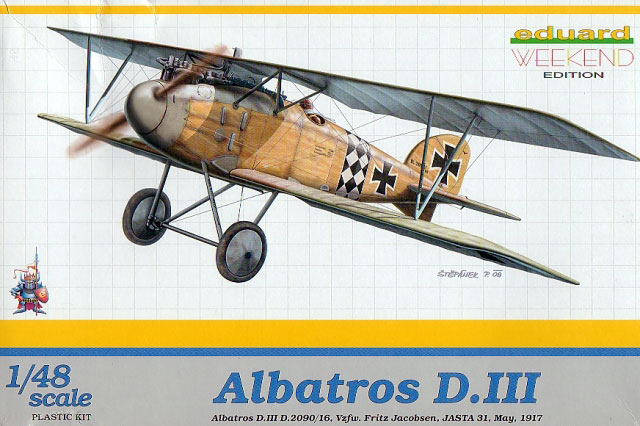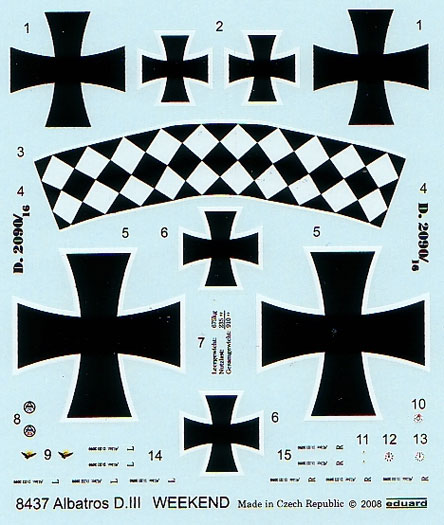Albatros D.III

Eduard Weekend Edition, 1/48 scale
S
u m m a r y |
| Catalogue Number: |
Eduard Kit No. 8437 - Albatros D.III Weekend Edition |
| Scale: |
1/48 |
| Contents and Media: |
97 parts in tan coloured plastic; markings for one aircraft |
| Price: |
USD$19.95 available online from Eduard
and hobby retailers worldwide |
| Review Type: |
FirstLook |
| Advantages: |
Crisp moldings, good detail, wings with subtle rib detail and sharp trailing edges, decal sheet in perfect register with minimal carrier film, competitive pricing. |
| Disadvantages: |
Undernourished main wheels |
| Conclusion: |
A “no frills” kit that allows the modeller to build an accurate Albatros D.III at a budget price. |
Reviewed by
Rob Baumgartner

Eduard's 1/48 Albatros D.III Weekend Edition is available online from Squadron.com
Eduard continues their popular “Weekend Edition” series with the release of kit 8437. It represents the Albatros D.III, an aircraft that became synonymous with many of Germany’s aces during World War One.
When this subject was first released in 1999 it was state of the art. The kit still holds up well today and is one of the easier WWI aircraft to assemble.
The cockpit is the logical starting point and it consists of no fewer than 19 parts. This area is further enhanced by the structural detail that is moulded onto the interior of the fuselage halves. The instructions are clear on where everything goes and even remind the builder to remove a couple of injection pin stubs.
The “office” is very comprehensive and Eduard delivers on all the necessary bulkheads, floor boards and a slightly too short cross-member. To these we attach items such as the ammunition bins, air pump, greaser, magneto, switches, spark control, rudder bar, seat and control column.
Everything fits snugly and once the fuselage halves are together the rest of the kit proceeds very quickly.
Each lower wing is attached via small locator tabs but some may want to strengthen this by pinning with a metal rod. The main flying surfaces are beautifully done with subtle ribs and sharp trailing edges.
The ailerons are moulded in situ and will need cutting out if one wants to animate their subject. Whether you do so or not, the missing control linkage and its associated cutout needs to be added.
A rigging diagram is included in the instructions while the side of the packaging gives the modeller the colour profiles for both decal placement and colour scheme. This, combined with the boxtop, should be enough for most modellers to correctly depict the option portrayed.
The kit was designed around Ian Stair’s 1991 revised general arrangement drawings. These appeared in the Albatros Productions “Datafile Special” on this series of fighter. As expected, the main components match the outlines very well although the wheels are decidedly undernourished.
Markings
A single subject is supplied on the well appointed decal sheet.
The items are sharply printed and in perfect register with minimal carrier film around each object. As well as the National Insignia and personal markings, there are other details for the modeller.

Axial and Albatros logos are supplied for the propeller and rudder respectively and dial faces cater for the cockpit instruments.
This aircraft was flown by Leutnant Fritz Jacobson of Jasta 31. It is fitted with an unusually high windscreen which has what appears to be a protective plate in front of it. Also seen on the starboard side is a rack for holding spare flare cartridges.
At a later stage of this aircraft’s life, the fuselage was mottled in a way that gave the appearance of having been decorated with flowers.
Fritz Jacobson was an 8 victory ace and was both a test pilot and instructor before the war. In 1915 he was the chief test pilot at Armee Flugpark II before moving to FA 1. He also went to Jasta 17 and Jasta 9 but it was Jasta 31 that he scored his first 4 victories although 2 were unconfirmed. Six more victories were scored after he moved to Jasta 73, the last on 4 September 1918. He survived the war and died in August 1981. He was 87.
This Eduard release is another welcome addition to their “Weekend Edition” series.
It is a “no frills” product which means it doesn’t contain any photo-etched parts, resin, or multiple colour schemes. The basic plastic items however, still allow the modeller to produce a quality result straight out of the box.
As such it is perfect for those that want to experience their first biplane kit.
Thanks to Eduard for the sample
Review Text Copyright © 2008 by Rob Baumgartner
Page Created 25 November, 2008
Last updated 25 November, 2008
Back to HyperScale Main Page
Back to Reviews Page |
